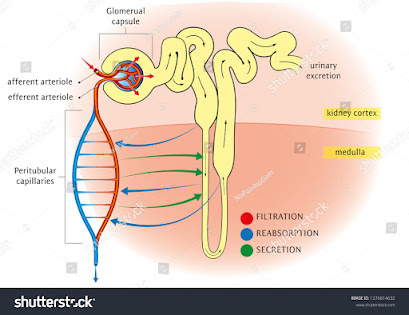OSMOREGULATION IN MAMMALS, FRESHFISH AND AMOEBA
Introduction
What is osmoregulation?
Osmoregulation is the maintenance of a uniform internal body environment known as homeostasis by balancing of the amount of salt and water in the body.
This is, achieved by regulating the amount of salt and water loss in this organism by altering salt and water balance. This principle is, well understood via a phenomenon known as “water follows sodium”.
The movement of water and chloride occurs in the same direction as the movement of sodium. Understanding the principle of osmosis makes us to better, appreciate homeostasis. Why? Because osmosis involves the movement of water from a region of elevated concentration to a region of low concentration across a selectively permeable membrane. Therefore, if we have more salt inside a cell than outside, water will turn to move into the cell since the concentration of H2O in the cell is lesser. Hence, H2O will move to create an equilibrium between the quantity of water in the cell and that out of the cell. This also stabilities the concentration of sodium. A substance is, said to be concentrated when it has little water in it.
Osmoregulation in fresh-water fish
After understanding what osmoregulation is all about, we are then going to talk about how osmoregulation occurs in freshwater fish. Freshwater fish has an increased ionic concentration compared to the surrounding water in line with to the presence of sodium in the blood of fish. The fish, at this state is, said to be hypertonic. Thus, they turn to facilitate water movement from the environment, through the mouth and gills into their system. Producing an enormous amount of urine which is then lost to the surrounding.
Osmoregulation in marine water fish
Osmoregulation in marine fish counteract that of freshwater fish because they have an enormous amount of water in them compared to their surrounding which is not the case for freshwater fish that instead has more salt in the blood than the surrounding water. So, in marine fish, water will be moving from the fish to the surrounding. The fish is, said to be hypotonic. Therefore, to prevent the loss of water, marine fish have the tendency to take in huge amount of water and prevent urination that might cause them to loss water.
Some marine animals have a relatively different method of conserving water loss by storing urea at a very elevated concentration thus preventing their elimination. Such examples can, be seen in shark.
Osmoregulation in Amoeba
Amoeba unlike the organisms, which we are trying to compare it with, is a unicellular organism that lives in water bodies as a single cell. Since it is unicellular, there is a constant movement of water into the cell due to the alteration in H2O concentration across the membrane but amoeba maintains homeostasis by creating a contractile vacuole that functions as a temporal store for water, thus collecting excretory products like ammonia into the contractile vacuole thanks to diffusion and active transport.
This vacuole then moves to the surface, binding to the membrane and causing the release of its content into the surrounding water.
Osmoregulation in Humans
Humans are a distinguished kind of multicellular organism but the method in which it uses to regulate water loss is similar to that of several other vertebrates. The kidney nephron as the functional part of the kidney and sweat glands function in the maintenance of a constant amount of water in the body via 4 steps.
- Firstly, glomerular filtration: this allows plasma to be filtered from the glomerulus to the Bowman’s capsule. The substance that is been filtered is known as the filtrate. The filtrate then moves to the proximal convoluted tubule and down.
- Secondly, selective reabsorption: this allows for absorption of substances required by the body into the cells from the proximal convoluted tubule. Almost all glucose and amino acid is, reabsorbed. Water and other substances like magnesium, calcium and zinc are also absorbed. These substances can be, absorbed by active transport or diffusion.
- Thirdly, tubular secretion: this permit for the elimination of substances that are not required by the body into the tubules, which then travel as urine to the collecting duct.
- Lastly, urine moves from the collecting duct to the ureter and to the bladder storing urine temporally. When need be, urine is then, eliminated into the environment via the urethra.
Note:
- in humans, the urethra is shorter in females (about 4cm) and longer in males (up to 25cm).
- A group of hormones and other entities can control osmoregulation in mammals. Aldosterone, Angiotensin II and Anti-Diuretic Hormones (ADH) function to avoid water loss by causing the captivation of water into the cells from the tubule and they also help in vaso constriction. Atrial natriuretic peptide helps to inhibit the production of ADH, angiotensin II and aldosterone and causing vaso dilation thus intensifying the amount of water loss from the tissues.
- In addition, there are 2 types of nephrons and they both function at different moments in time. The cortical nephron functions under normal circumstances and juxtaglomerular nephron functions in situations where there is need for water retention because it has a longer loop of Henle.
You can ask questions on the comment section below and also brief on anything you need articles on. Don't forget to pass by and check your replies.








0 Comments
You can drop questions on the comment section below